Tucked in the Japanese Cultural Centre, walking into Kaiseki
Yu-Zen Hashimoto transports you to another country. Given their limited
seating, their doors may be locked, so give the posted number a call and in no time,
someone will greet you at the entrance and lead you through the orange torii
gates into the dining room.
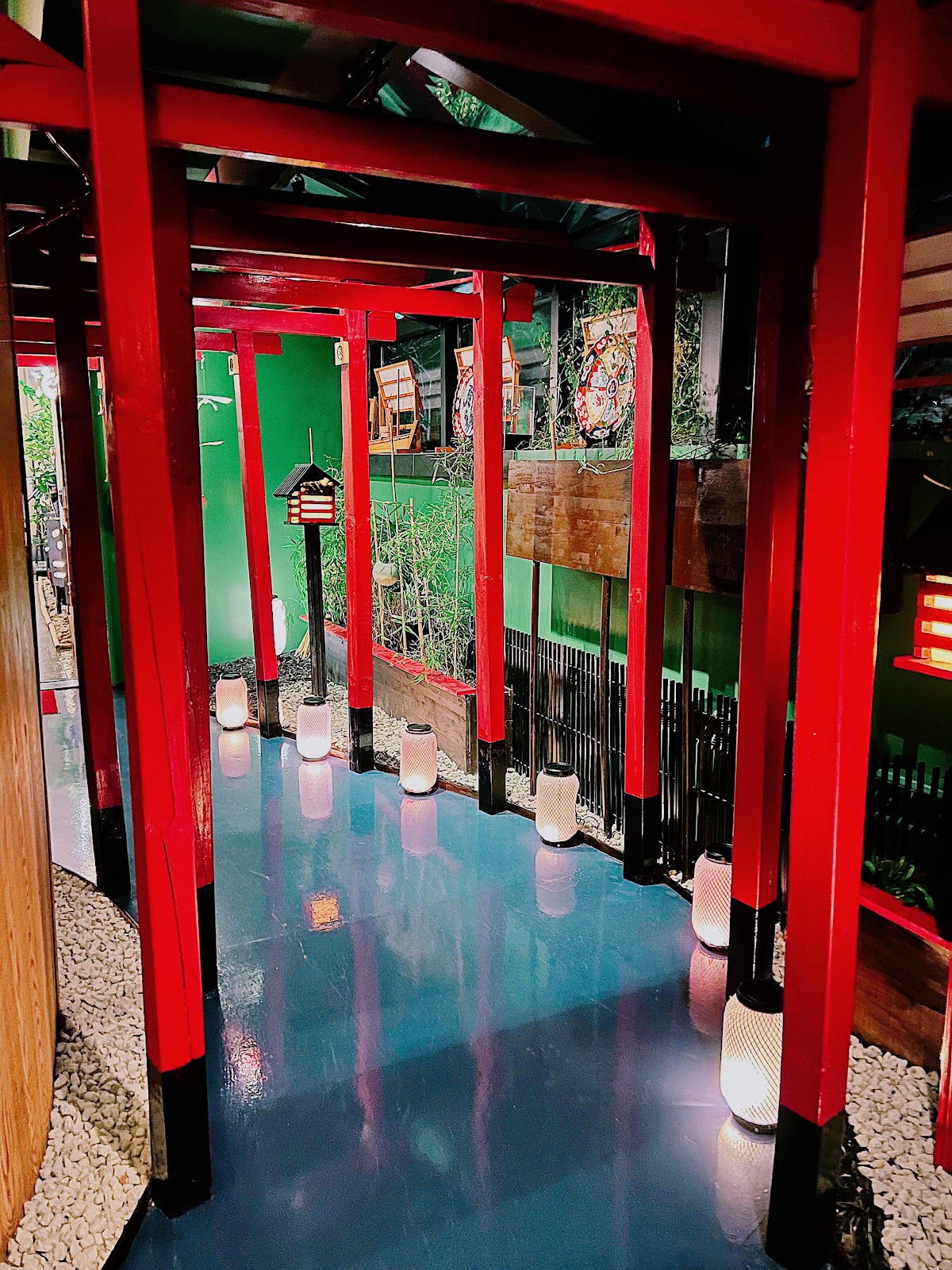
There’s so much to take in that the first ten minutes is
like sensory overload. Take a deep breath and get ready for the meal; Hashimoto
only serves three tables an evening, there’s plenty of time to explore after
dinner. So, settle into your private dining room and decompress for the meal to
come.

Hashimoto describes kaiseki as “much of an art form
as a style of food preparation” and this is certainly accurate. Each dish was
beautiful and like a gift waiting to be unwrapped; a sense of excitement settled
over me as I lifted the dome from many of the courses.
The eight-course meal ($350 per person) began with an onjyaku-zen
(amuse bouche) consisting of three hearty soups designed to warm-up the
stomach. Hashimoto’s saikyo miso soup wasn’t overly salty but rather
rich in umami made with white miso, topped with a braised carrot, and a
pea-sized amount of mustard to add an expected spice against the broth. Meanwhile,
the nutty flavour that burst through the cube of goma (sesame) tofu was incredible,
almost bordering bitter if it weren’t balanced out by the thick savoury soup. If
anything, I could have done without wasabi on the tofu as the sesame taste was
already so pungent.

Of all three bowls, my favourite was also the simplest and what
Hashimoto calls “seasoned rice”. It’s like a thick congee studded with cubes of
sweet soft squash and topped with slivers of salty dried kelp (?). The bowl was
lovely and comforting and had us wanting another taste of it to end the meal.
Paper thin slices of tennen madai (line caught sea
bream) was featured in the sashimi course, so delicate that it’s like eating
flower petals made of fish. Around the plate were three agar jellies flavoured
with ginger, carrot, and seaweed, as well as a washer-sized daikon filled
with thinly julienned pickled vegetables. It’s a much lighter dish following
the onjyaku-zen and really showcases the knife skills of Chef Masaki
Hashimoto.

Diners are asked to refrain from wearing strong scents to
ensure they’re able to enjoy the sensory experience of the food. The yuzu aroma
that escapes from the owan-mono was so refreshing, although at first
whiff, it leaves me wondering if a citrusy soup is something I’d enjoy.
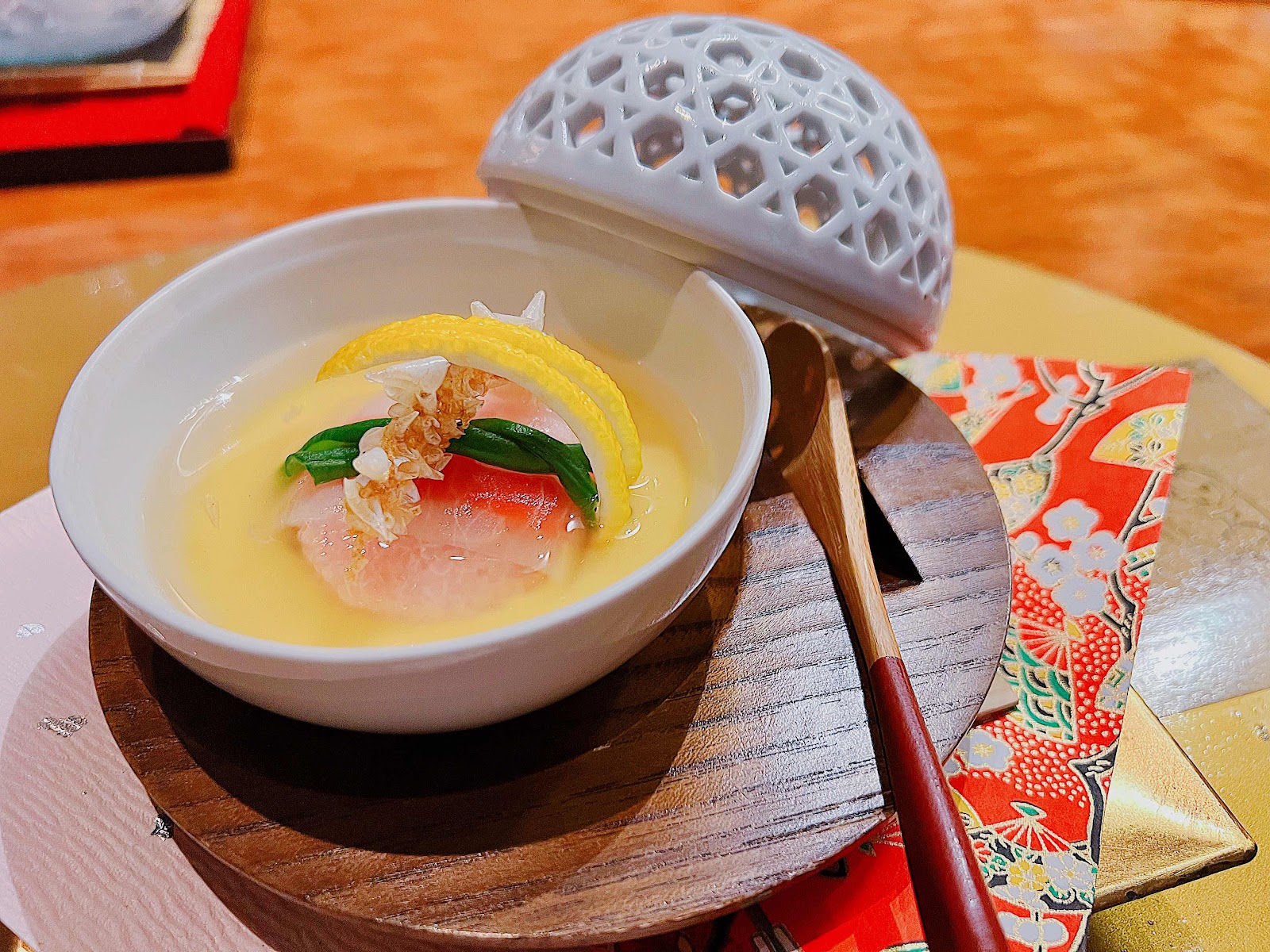
Hashimoto didn’t disappoint, balancing the yuzu in a
savoury consommé and pairing it with a host of rich flavours: a silky chawanmushi
(egg custard), a thick chewy rice cake, and a soft braised daikon. The slice
of amadai (tile fish) was cooked perfectly and I loved that the fish’s
scales were deep fried to form a crunchy garnish on top.
The yaki-mono (grilled course) featured a host of
ingredients that were in-season during the autumn in Japan. Generally, I only
have persimmons raw, yet somehow the fruit tastes so good baked, releasing more
of its sweet flavours with chewy pieces of mochi included to soak up
some of its juices. The fruit was so inventive that the grilled shima-aji (stripe
jack) almost seemed secondary; I found the fish a tad overcooked and in need of
a stronger glaze to make it stand out.
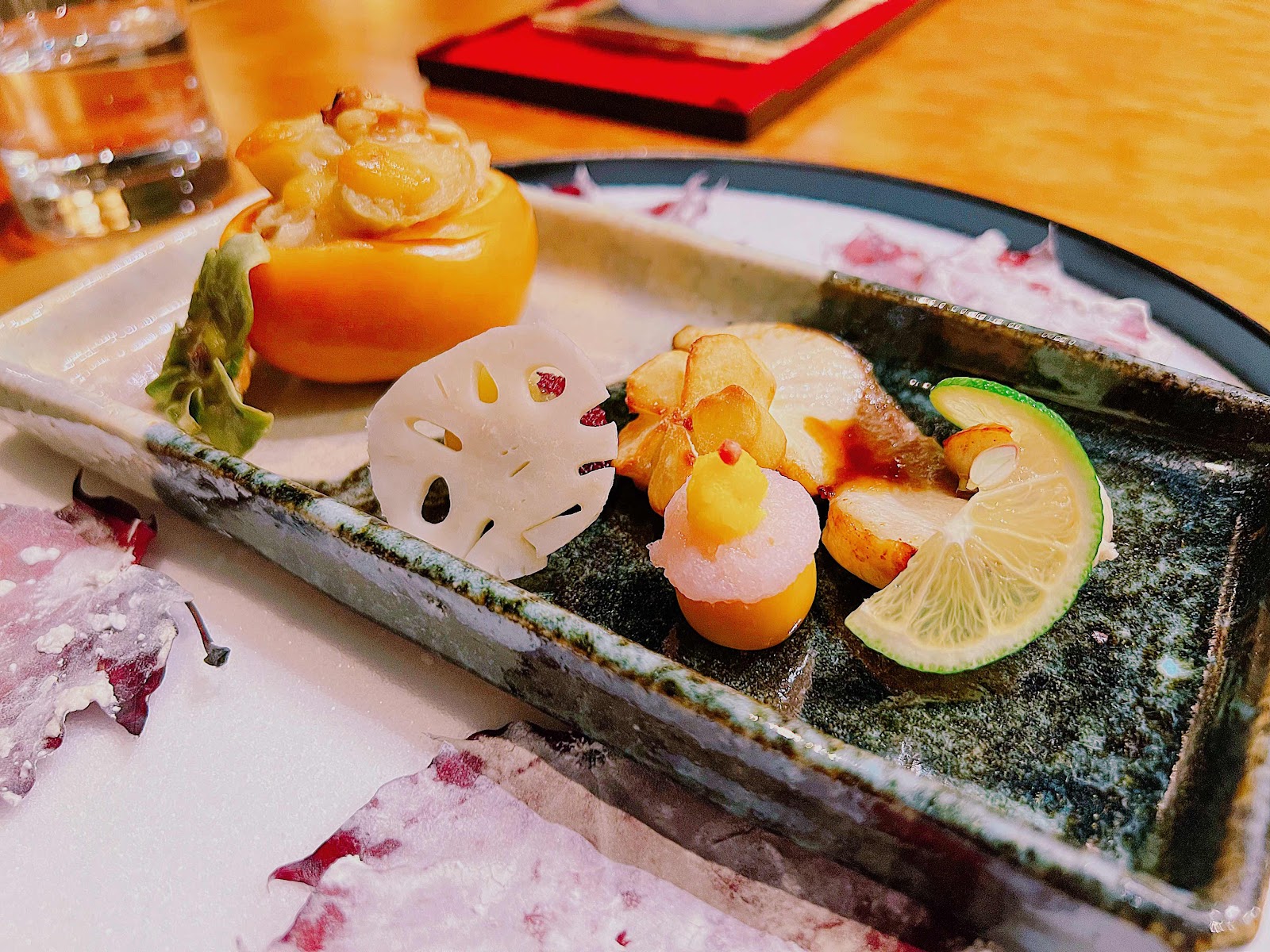
To finish the yaki-mono a host of seasonal produce were
used as palette cleansers including crisp lotus root, a gooseberry topped with
egg yolk (surprisingly, it works), mountain yam, and a lovely mountain peach
that’s almost tastes like a cross between a plum and strawberry.
The Spice Girl’s song, When Two Becomes One, is what
comes to mind when I think of the taki-awase course. The dish begins
with ingredients being stewed separately – in this case, cubes of octopus,
vegetables, squash, and daikon – and are then steam together to blend the
flavours and aromas without causing the ingredients to become overcooked. After
simmering for four hours, the octopus was so tender that if our server didn’t
tell us what the protein was, I would have thought we were eating brisket.
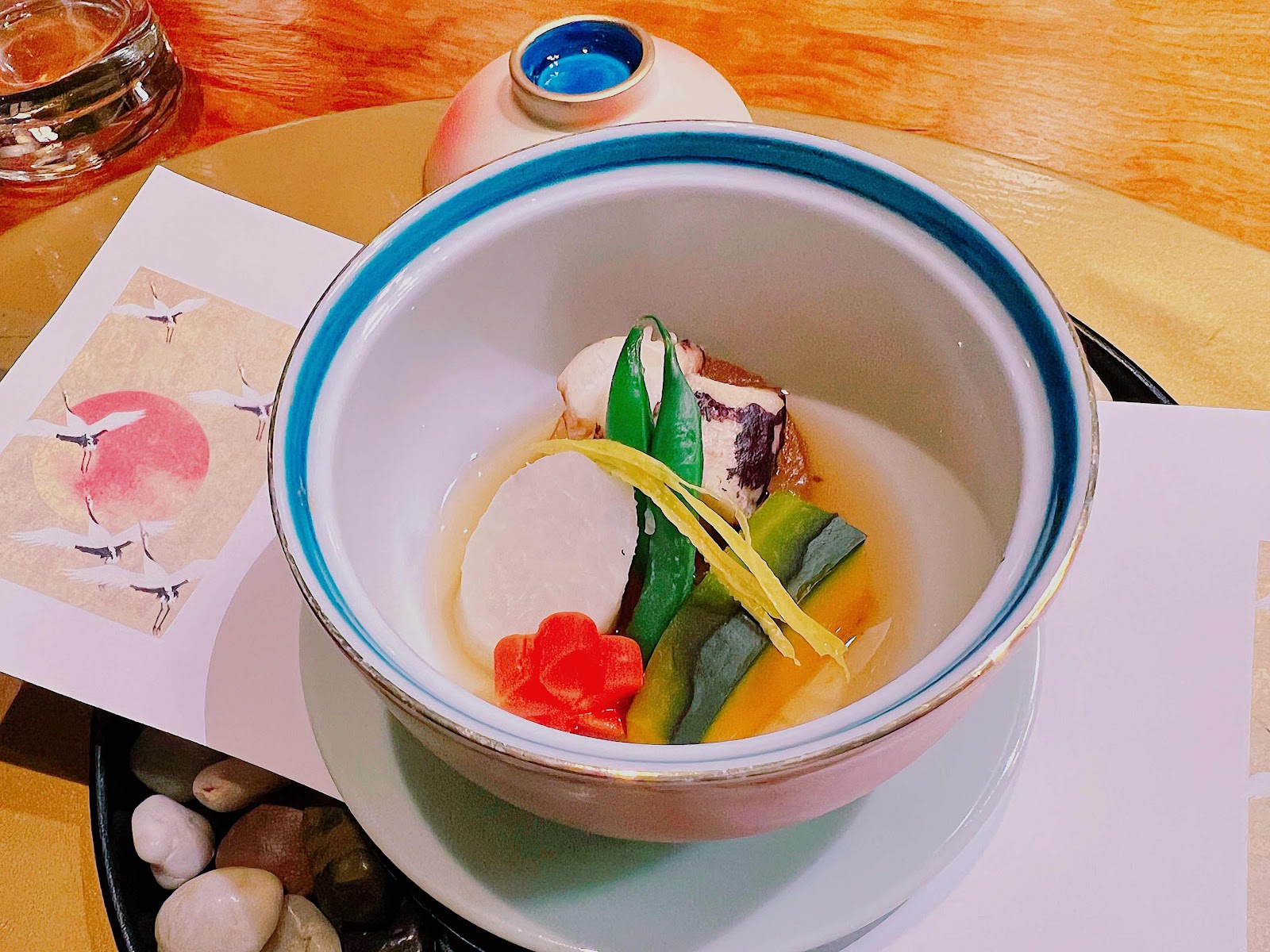
Following the softer steamed dish was the shii-zakana (signature
course), which provided a textural contrast with different crispy elements:
- Medallions of the most incredible chicken teriyaki
encapsulating a soft walnut and wrapped in a thin crispy skin. I could munch on
rounds of these in lieu of chicken wings.
- A ball of flavourful mashed Japanese potatoes filled with wagyu
beef cubes and rolled into crispy rice grains creating something that
rivals arancini with its crunchy and soft elements. Of course, in this
case, instead of the traditional ground beef and peas, it’s filled with rich wagyu.
Oh boy.
- Even the garnish of popped wheat was edible; a bit fibrous
when I took a bite of the entire stalk, but once we started picking out the
individual grains from the husk, became almost like a nutty popcorn.

Guilt washed over me as I took my first bite of Chef
Hashimoto’s hand carved radish crane… it must have taken so much time to carve its
delicate neck and legs! It was the last thing consumed so that I could
appreciate its beauty before finally dipping it into the carrot sauce and
devouring the refreshing décor.
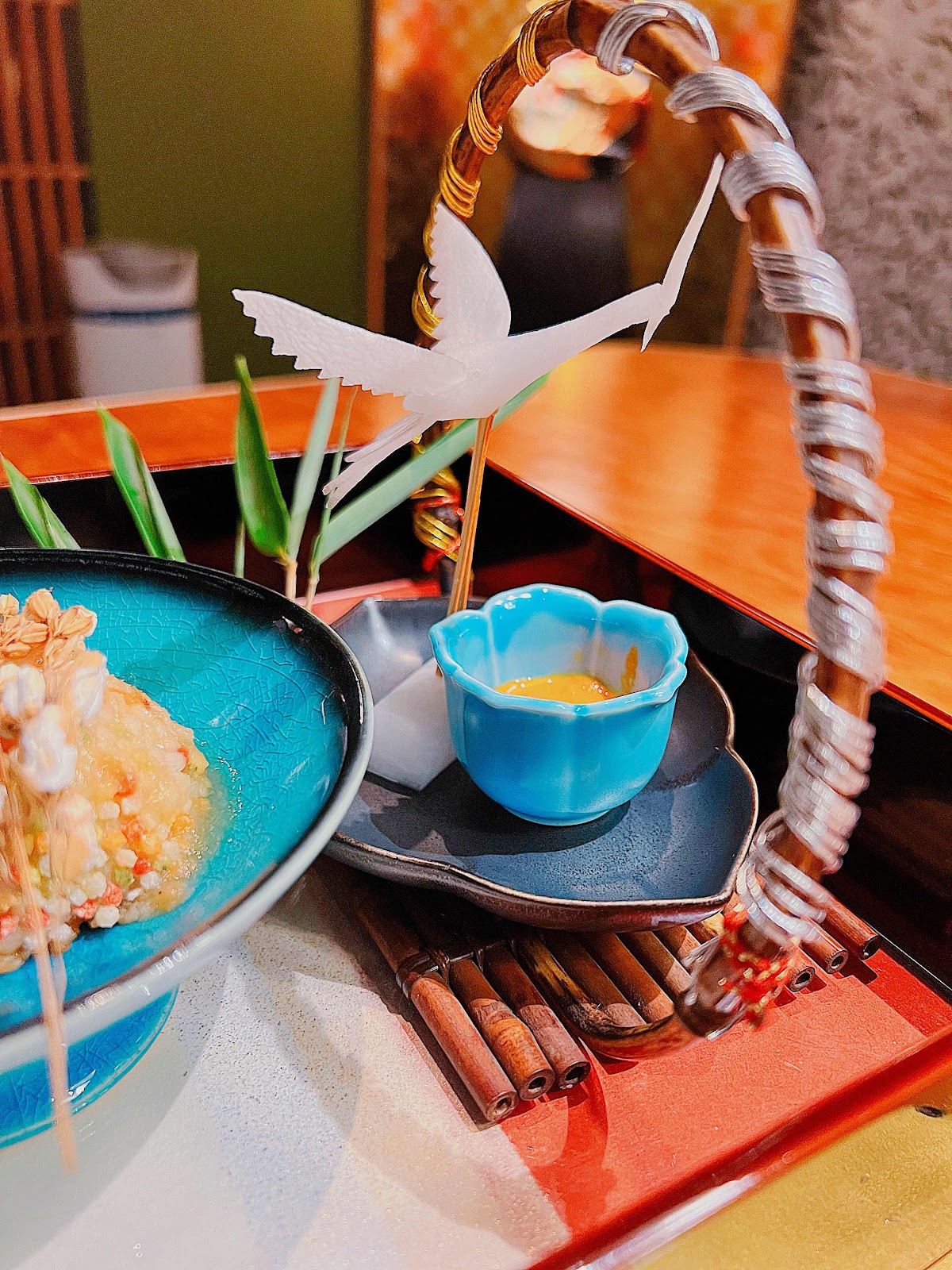
The last savoury course brought a bowl of sticky rice topped
with slices of A5 Hyogo wagyu, the prized beef from the Kobe region. While
it was delicious, I do wish the beef was left thicker and cut into cubes so
that more of the fatty rich flavours would be locked in and flow onto the
tongue.

A bowl of noodles and soup is always a delight. In this
case, a cha (tea) soba served in a fragrant dashi broth that was good to
the last drop. What a lovely way to end and cleanse the palette before dessert.
Like many Japanese desserts, the mizu-mono was a
fruit plate prominently featuring the expensive Shizuoka musk melon. A sizeable
melon is upwards of $200 a fruit and commands the premium as supposedly they
are raised to only have one melon per plant to ensure all the flavours are
concentrated into one fruit and there being less of a chance of the melon
having blemishes.
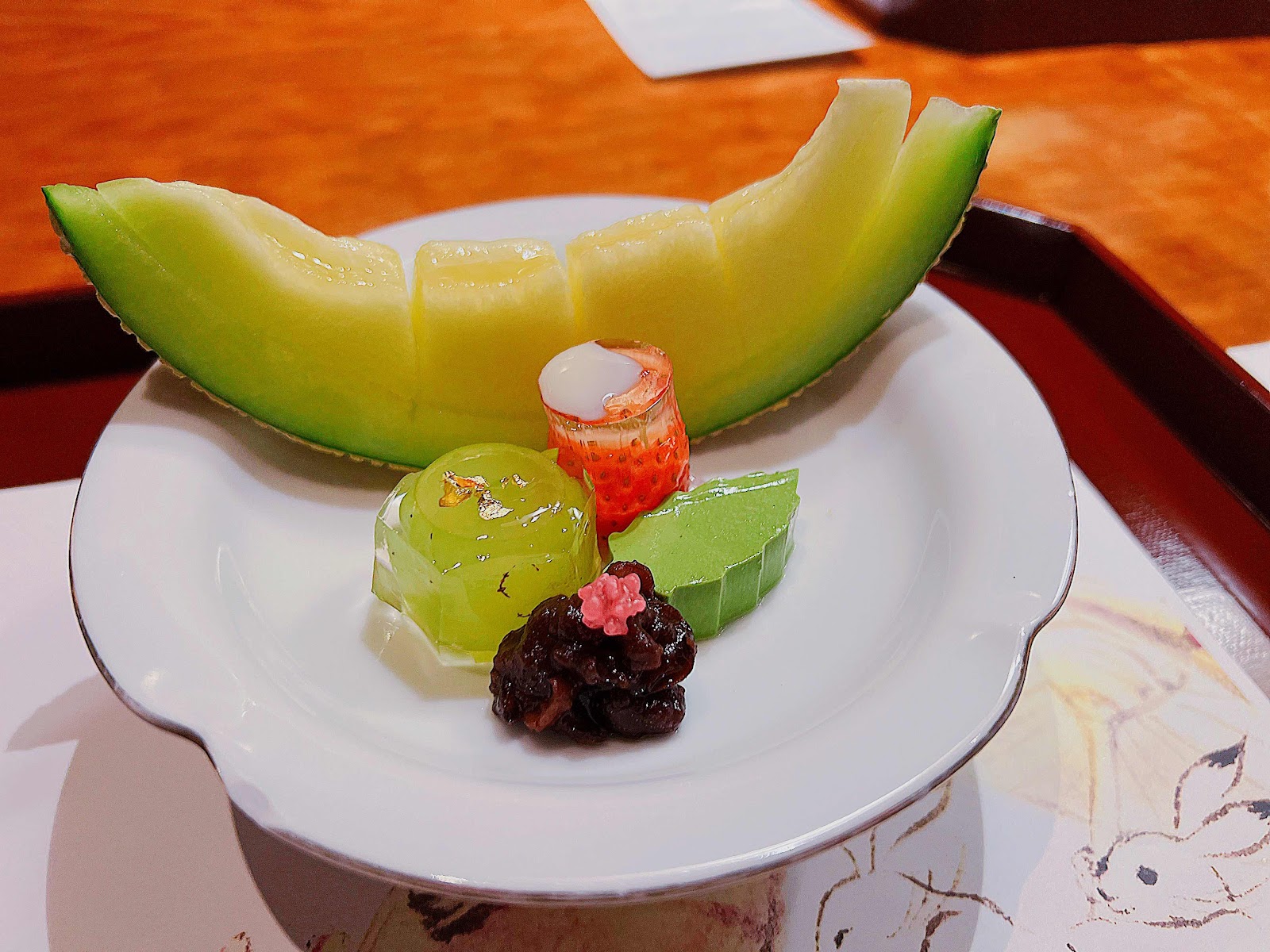
Indeed, every time I’ve had a slice it’s the sweetest melon
ever and tastes like a cross between cantaloupe and honeydew. What also makes
it different is the texture: when you have a normal melon it tends to be very
soft and sweet in the centre, then gets hard and flavourless as you approach
the find. The musk melon tends to have a more uniform sweetness and tenderness
throughout.
It’s strange when I’m excited to try fruit, at Hashimoto
they also provided a white strawberry encapsulated in a light jelly and topped
with condensed milk. Truthfully, it just tasted like a lighter Ontario
strawberry that you can purchase at a farmer’s market when it’s in season… I
don’t think I would pay the ~$40 for a pint. It was my first experience having
a shine muscat, which was like a sweeter and juicier globe grape without seeds.
Set in gelatin and adorned with a gold leaf it’s crazy to think that a bunch of
these grapes can be upwards of $100.
Aside from the fruit, we were treated to a leaf of uber-rich
matcha pudding and a dollop of sweet azuki beans topped with a crispy
candy. My recommendation is that Chef Hashimoto switches out the rock sugar
with pop rocks to really give the diners a surprise.
With an extensive sake menu, if you’re not familiar with the
Japanese spirit, they have a “sommelier” to help you choose one based on your
preferences for other alcohol. Letting her know that we like a dry crisp wine,
she recommended the Okunomatsu Junmai Ginjo Genshu Arabashiri that was offered
in a half bottle on weekends ($55), which does have a less sweet finish.

For those who are abstaining from alcohol, they also offer
pots of fragrant tea ($9 a person) or water served from a kimono clad Swell
bottle ($7 a person).
Incredible surroundings and beautiful unique dishes aside,
what makes dining at Kaiseki Yu-Zen Hashimoto an unforgettable experience is
their service. With only three tables nightly, we were in good hands – just
like in Japan, the hospitality rises to another level.
It evens ends warmly with our server offering to take a
picture of us, which they email to us later that evening along with pictures of
the dishes sampled. It’s a simple and sweet gesture that sets the restaurant
apart, from the moment you enter and after you return home, dining at Kaiseki
Yu-Zen Hashimoto is a true sensory experience.
Overall mark - 8 out of 10
How To Find Them
Location: Toronto, Canada
Address: 6 Garamond Court
Follow me on twitter to chat, be notified about new posts and more - https://twitter.com/GastroWorldBlog
____________________________
Gastro World's Grading System
- Anything under 5 - I really disliked and will never go back
- 6 - decent restaurant but I likely won't return
- 7 - decent restaurant and I will likely return
- 8 - great restaurant that I'd be happy to recommend
- 9 - fantastic restaurant that I would love to visit regularly and highly recommend
- 10 - absolute perfection!
Is That It? I Want More!
Other Gastro World posts similar to this:






































